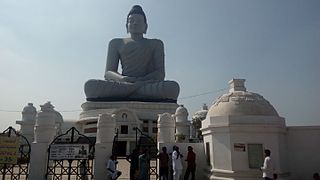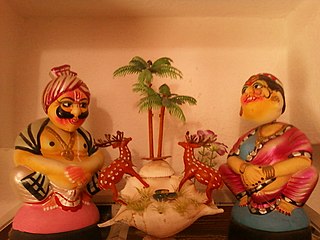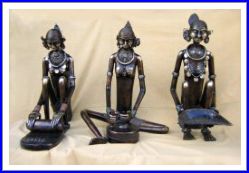Related Research Articles

Andhra Pradesh is one of the 28 states of India, situated in the south-east of the country. It is the seventh-largest state in India, covering an area of 160,205 km2 (61,855 sq mi). As per the 2011 census, it is the tenth-most populous state, with 49,386,799 inhabitants. The largest city in Andhra Pradesh is Visakhapatnam. Telugu, one of the classical languages of India, is the major and official language of Andhra Pradesh.

Srikakulam district is one of thirteen districts in the Indian state of Andhra Pradesh, with the headquarters located at Srikakulam. It is one of the nine coastal districts, located in the extreme northeastern direction of the state. It was formerly known as Chicacole.

Venkatagiri is a town in Nellore district of the Indian state of Andhra Pradesh. It is a municipality and mandals headquarters of Venkatagiri mandal. Venkatagiri's old name is "Kali Mili". It is famous for its Handloom Cotton Sarees. Venkatagiri is a place for history and handlooms. It was part of a small kingdom that was integrated into the Indian Republic.
Naga shawls are traditional shawls with a distinctive pattern made by various Naga tribes from Nagaland in India.
Guntur Sannam or Capsicum annuum var. longum, is a type of chili pepper that grows in the districts of Guntur, Warangal (Telangana), and Khammam in India. It is registered as one of the geographical indications of Andhra Pradesh.
Uppada Jamdani Sari is a silk sari style woven in Uppada of East Godavari district in the Indian state of Andhra Pradesh. It was registered as one of the geographical indication from Andhra Pradesh by Geographical Indications of Goods Act, 1999. Uppada Jamdani saris are known for their light weight.
Venkatagiri Sari is a sari style woven in Venkatagiri of Nellore district in the Indian state of Andhra Pradesh. It was registered as one of the geographical indication from Andhra Pradesh by Geographical Indications of Goods Act, 1999. Venkatagiri saris are known for their fine weaving. These style of saris can also be found in the villages of Sengunthapuram, Variyankaval, Elaiyur, Kallathur, Andimadam and Marudhur villages.

Kondapalli Toys are the toys made of wood in Kondapalli of Krishna district, a village nearby Vijayawada in the Indian state of Andhra Pradesh. Bommala Colony translates to Toys Colony in Kondapalli is the place where the art of crafting takes place. It was registered as one of the geographical indication handicraft from Andhra Pradesh as per Geographical Indications of Goods Act, 1999. These toys were one of the variety of toys assembled in the houses during the festivals of Sankranti and Navratri and is referred as Bommala Koluvu.

Pedana Kalamkari also known as Machilipatnam style of Kalamkari work which involves vegetable dyed block-painting of a fabric. it is produced at Pedana a nearby town of Machilipatnam in Krishna district of the Indian state of Andhra Pradesh. It was registered as one of the geographical indication from Andhra Pradesh under handicraft goods by Geographical Indications of Goods Act, 1999.
The Geographical Indications of Goods Act, 1999 is a sui generis Act of the Parliament of India for protection of geographical indications in India. India, as a member of the World Trade Organization (WTO), enacted the Act to comply with the Agreement on Trade-Related Aspects of Intellectual Property Rights. The GI tag ensures that none other than those registered as authorised users are allowed to use the popular product name. Darjeeling tea became the first GI tagged product in India, in 2004–05, since then 323 goods had been added to the list as of August 2018.

Bagh Print is a traditional Indian handicraft originating in Bagh, Dhar district of Madhya Pradesh, India. The process is characterised by hand printed wood block relief prints with naturally sourced pigments and dyes. Bagh print fabric motifs are typically geometric, paisley, or floral compositions dyed with vegetable colours of red and black over a white background, and is a popular textile printing product. Its name is derived from the village Bagh located on the banks of the Bagh River.
Mangalagiri Sarees and Fabrics are produced by performing handicraft weaving in Mangalagiri, a town in Guntur district of the Indian state of Andhra Pradesh. It was registered as one of the handicraft in the geographical indication from Andhra Pradesh by Geographical Indications of Goods Act, 1999. The Mangalagiri fabric is produced by weaving with the help of pitlooms from combed yarn by warp and woof interlacing. The fabric then undergoes the process of dyeing. The Nizam design is another characteristic of the fabric.

Srikalahasti Kalamkari is a style of Kalamkari work which involves dyed hand-painting of a fabric. It is produced in Srikalahasti of Chittoor district in the Indian state of Andhra Pradesh. It was registered as one of the geographical indication from Andhra Pradesh, under handicraft goods by Geographical Indications of Goods Act, 1999.
Dharmavaram handloom pattu sarees and paavadas are textiles woven by hand with mulberry silk and zari. They are made in Dharmavaram of Anantapur district in the Indian state of Andhra Pradesh. It was registered as one of the geographical indication from Andhra Pradesh by Geographical Indications of Goods Act, 1999.

Screw pine craft of Kerala is the craft of making different types of mats and wall hangings using the leaves of the screw pine plant as paractised by artisans in Kerala. As per an application filed by Development Commissioner (Handicrafts), Ministry of Textiles, Government of India, "Screw pine craft of Kerala" has been granted Registration in Part A in respect of Mats, Door Mats, Wall Hangings, Bed Mats, Prayer Mats falling in Class – 27 under Sub-section (1) of Section 13 of Geographical Indications of Goods Act, 1999 with effect from 30 November 2015.

Brass broidered coconut shell craft of Kerala is the craft of making beautifully carved and brass broidered products like cups, flower vases, snuff boxes, nut bowls, powder boxes and spoons using coconut shells as practiced by the artisans of Kerala in India. This art requires great skill on the part of the artisan as the shell is extremely hard. The main centres of production in Kerala are located in Thiruvananthapuram and Kozhikode Districts. Though the coconut shell craft is also prevalent in Goa, Tamil Nadu, Pondicherry, Andaman and Nicobar Islands and West Bengal, the brass broidered variety is practiced only in Kerala.

Bastar Wooden Crafts are traditional Indian wooden crafts that are manufactured in the Bastar district of Chhattisgarh state, India. The wood-crafting work has been protected under the Geographical indication (GI) of the Agreement on Trade-Related Aspects of Intellectual Property Rights (TRIPS) agreement. It is listed at item 84 as "Bastar Wooden Craft" of the GI Act 1999 of the Government of India with registration confirmed by the Controller General of Patents Designs and Trademarks.

Santiniketan Leather Goods are leather products made in Santiniketan and surrounding villages near Kolkata, West Bengal, India. The material used is vegetable tanned leather with art work done by touch dyeing. Its artistic leather bags are popular in foreign markets and are exported to many countries including Japan and the U.S. They are generally made of E. I. Leather from sheepskin and goatskin.
The Surat Zari Craft is a textile product of Surat district in Gujarat, India, which is made from yarns of silk and cotton mixed with gold, silver or copper. The zari threads are used to make intricate designs by weaving into generally silk fabrics. Its use is extensive in textile industries and handicrafts. The Surat Zari is either woven on cloth or hand embroidered to form fabric borders or used as part on the body of the cloth. The zaris are used in fabrics made in Varanasi and a few other places in Uttar Pradesh, Tamil Nadu, Karnataka and Andhra Pradesh. Banarasi saris made in Varanasi and Kanjivaram Saris of South India use Surat Zari extensively.

The Nachiarkoil lamp, also called Annam lamp or Nachiarkoil Kuthuvilakku, is an ornamental brass lamp made of series of diyas, a handicraft product which is exclusively made by Pather (Kammalar) community in Nachiyar Koil town in Tamil Nadu, India. The lamp, which is hollow cast, is made in different sizes and consists of four parts which are screwed together. The central pillar that crowns at the apex is called the "Prabhai"; it is generally in the form of a hamsa or swan. The lamp may also be made in the form of a female figurine holding a shallow bowl in a standing posture, or in the form of branches of a tree; the bowl of these lamps has five V-shaped spouts which hold cotton wicks, and is filled with oil for lighting. The ornamental lamps are widely used in temples in South India.
References
- 1 2 "Budithi Brassware". AP Tourism. Retrieved 3 February 2016.
- ↑ "Geographical Indication". The Hans India. 23 January 2016. Retrieved 3 February 2016.
- ↑ "Registration Details of Geographical Indications" (PDF). Intellectual Property India, Government of India. Retrieved 14 May 2019.
- ↑ "Traditional crafts attract delegates". 14 February 2009. Retrieved 3 February 2016.